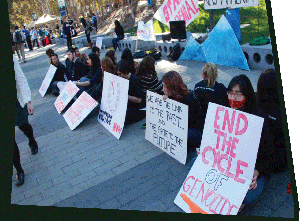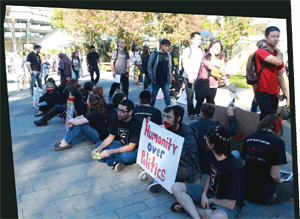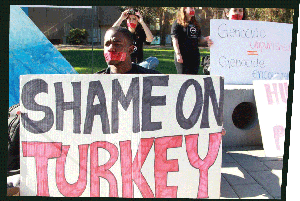Stain of Denial: Cultivating Silence in Advocacy
By: Nare Kupelian
The voice is a human gift to be embraced and used. It is through speech that one may relay their most pertinent ideas and engage others with their vision. Yet, the spoken word is an obligation, viewed as an essential in the advocacy of any cause. But the ability to remain silent, constitutes a strength in and of itself, and allows each person to foster their power. We have created tactics and methods that aim to generate the greatest amount of noise, which have, nonetheless, proven to be successful in the past. Yet, we have passed over the notion of silence as a tool for the mass portrayal of a message as well as the increased consciousness of individuals.
 On Thursday, January 26, 2012, the affiliated schools and organizations of the Confederation of All-Armenian Student Associations joined in silence to protest the denial of the Armenian Genocide. Silent protests were organized in conjunction at UCLA, USC, UCSD, UCSB, UC Irvine, Cal State LA and CSUN. The “Stain of Denial” was aimed at informing the greater campus communities about the Armenian Genocide and the ensuing denial campaign by the government of Turkey. Through their individual student bodies, the respective All-ASA organizations spread the collective message of the detrimental effects of injustice and denial, generations after the initial crime was committed. Covering their mouths with tape and bearing written signs as testaments of their message, hundreds of college students coalesced to condemn the cyclical precedent of the repression of justice. Following the passage of legislation in France criminalizing the Armenian Genocide, these students encouraged the US government not to succumb to political bullying and reject Turkey’s gag rule.
On Thursday, January 26, 2012, the affiliated schools and organizations of the Confederation of All-Armenian Student Associations joined in silence to protest the denial of the Armenian Genocide. Silent protests were organized in conjunction at UCLA, USC, UCSD, UCSB, UC Irvine, Cal State LA and CSUN. The “Stain of Denial” was aimed at informing the greater campus communities about the Armenian Genocide and the ensuing denial campaign by the government of Turkey. Through their individual student bodies, the respective All-ASA organizations spread the collective message of the detrimental effects of injustice and denial, generations after the initial crime was committed. Covering their mouths with tape and bearing written signs as testaments of their message, hundreds of college students coalesced to condemn the cyclical precedent of the repression of justice. Following the passage of legislation in France criminalizing the Armenian Genocide, these students encouraged the US government not to succumb to political bullying and reject Turkey’s gag rule.
A sudden silence ensuing on a normal school day in January can really take us back to the fundamentals. It takes the silent portrayal of our message to reveal to us the multi- faceted approaches involved in the advocacy of our cause. Through my participation in the silent protest at UCSD, I saw a dynamic overcome the participants throughout the day. As students first arrived, they giggled in skepticism when we placed tape over their mouths, handed them a poster and asked them to sit silently in a high-traffic area on campus. Hesitant at first, they continuously peeled off their tape, distracted themselves with conversations, and mingled with friends. After about an hour, a certain sense of solemnity came over the participants, as the gravity of their task seemed to finally settle in. Silence ensued and each person became cognizant of their individual contribution in our collective message. Contemplating over their current situation, a certain aura of consciousness was obvious within each student, recognizing the substantive importance of the message they were relaying. Instead of being merely supportive of an event or project, these students were the spectacle themselves, feeling the characterization on their own skin and physically carrying the label of their message.
faceted approaches involved in the advocacy of our cause. Through my participation in the silent protest at UCSD, I saw a dynamic overcome the participants throughout the day. As students first arrived, they giggled in skepticism when we placed tape over their mouths, handed them a poster and asked them to sit silently in a high-traffic area on campus. Hesitant at first, they continuously peeled off their tape, distracted themselves with conversations, and mingled with friends. After about an hour, a certain sense of solemnity came over the participants, as the gravity of their task seemed to finally settle in. Silence ensued and each person became cognizant of their individual contribution in our collective message. Contemplating over their current situation, a certain aura of consciousness was obvious within each student, recognizing the substantive importance of the message they were relaying. Instead of being merely supportive of an event or project, these students were the spectacle themselves, feeling the characterization on their own skin and physically carrying the label of their message.
Cultivating silence as a means of advocacy has proven challenging, as it lacks the galvanizing effect of the fervent, loud desperation of spoken word. Silence and powerlessness are often equated through a causal relationship. Nevertheless, where silent demonstrations lack in ardency, they make up for in attracting inquisitive interest. From the  participant standpoint, what seemed elusive and were solely held as ideas, had now became a tangible reality. Individuals were challenged to not only advocate the reality of our issue, but to become a representative part of it. To the unknowing passerby on campus at these colleges, written messages and their human characterizations incited curiosity as to the rigor of this sit-down, silent demonstration. Media coverage, via school and community newspapers, television news networks, magazines, and blogs, created a vibrant buzz around events where virtually no words were spoken. Almost all participating schools had segments published in either their community or school newspapers, with several protesters being featured on the covers of well-known school media.
participant standpoint, what seemed elusive and were solely held as ideas, had now became a tangible reality. Individuals were challenged to not only advocate the reality of our issue, but to become a representative part of it. To the unknowing passerby on campus at these colleges, written messages and their human characterizations incited curiosity as to the rigor of this sit-down, silent demonstration. Media coverage, via school and community newspapers, television news networks, magazines, and blogs, created a vibrant buzz around events where virtually no words were spoken. Almost all participating schools had segments published in either their community or school newspapers, with several protesters being featured on the covers of well-known school media.
There are many situations in which silence has the loudest voice. The ability for a person to say nothing and stand for a cause nurtures a great strength and understanding. What is said through spoken word is understood, but what is said through silence is felt. Part of our responsibility as student leaders is to ensure that there is a resonant consciousness among our student bodies of the issues that we all represent. Before we can render others responsible for our causes, we need to promote education and understanding within our own ranks. The collective message will be relayed, be it through traditional modes of demonstration or newly employed tactics, but focus on developing the individual advertence to our cause is a priority. Thus, it was this very zeal for raising awareness and setting demands that incited hundreds of college students to demonstrate that sometimes saying nothing actually says the most.



Leave a Reply
Want to join the discussion?Feel free to contribute!